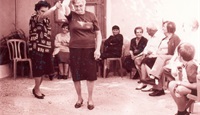
Applicant:
Limassol Folklore Association (2017)
Politistiko Ergastiri Ayion Omoloyiton (2020)
Limassol Cultural and Dance Club "Dionysos" (2020)
"ALEXANDRA" Dancing Workshop (2022)
Communities Concerned - Bearers of the element:
Limassol Folklore Association and other dance, folklore and cultural associations, dancers and dance teachers, dance students (boys and girls), traditional music and dance schools, dance ensembles and cultural societies/ diaspora associations, players of traditional musical instruments, primary and secondary education schools, music schools (high schools and colleges), Training Centres attached to the Ministry of Education and Culture, pedagogical schools under tertiary academic institutions, physical education teachers, members of folklore and cultural societies, ethnomusicologists, folklorists, anthropologists, academics and tradition researchers mainly from Greece and Cyprus.
Domain of Intangible Cultural Heritage:
Oral traditions
Performing arts
Date of inscription:
2017
Geographical distribution:
Nation-wide geographical distribution of the element (rural as well as urban areas) but also in the Cypriot diaspora communities in Europe, America, Africa and Australia.
Experienced older dancers and renowned first dancers and dance teachers play an important role in preserving the personal temperament in the performance of traditional dances vis-à-vis the trend of creating uniformity which arose from the choreographies of the second half of the 20th century. These experienced dancers still perform the dances in their private/family lives and at various social events in a spontaneous and original manner with a lot of improvisation.
Brief description:
Cypriot traditional dances constitute the main form of expressing the oral and traditional musical culture of Cyprus. As a means of expressing and communicating Cypriot identity and emotions, as a mode of entertainment and display of dancer’s artistic sensitivity and skills, Cypriot traditional dances are danced by men, women and children. They are associated with important moments of private/family as well as collective/community life of Cypriots wherever they may be: religious feasts, weddings, celebrations etc.
As an integral part of the music and dance traditions of the broader Hellenic world, the repertoire of the Cypriot dances has adopted, adjusted and incorporated dance and musical elements from several musical traditions of the Hellenic civilisation, such as those of Asia Minor and Cappadocia. The repertoire includes men’s dances, women’s dances, individual men’s dances displaying virtuosity danced with a hand-held object or tool, comical dances and others. The most common dance for men and women is one performed in pairs confronting each other known as “kartchilamas” (which comes from the Turkish word karşı meaning “across from”). In the context of the traditional Cypriot society as this was functioning until the 1970s, these confronting dances were danced exclusively by two people (either two men or two women). Women danced separately from men.
The main feature of Cypriot traditional dances is the element of improvisation. By preserving the main elements of the dance tradition (movements, dance moves, “steps”) each dancer – male or female – would attempt to show off his/her own sensitivities and skills. This would give rise to a dialogue between musicians, dancers but also spectators.
Apart from the singing, the instruments that accompanied the dances were the violin, the lute (a four-chord folk musical instrument providing mainly the rhythmic and harmonic support), and sometimes a percussion instrument like a frame drum called “tamboutchia” which is basically a kitchen pot played with the palm and fingers or with two small sticks. The “tamboutchia” used to provide the accompaniment for the dancers when there was no lute or any other instrument. In addition, those skilled players of “pithkiavli” (a type of a fipple flute used by shepherds) could play the repertoire of Cypriot dances and accompany the dances in spontaneous moments of joy and revelry in order to sustain all those endless hours of hard work in the fields, or animal grazing etc.
The main method of learning Cypriot folk dances was by absorbing the dances and the musical repertoire empirically by following renowned and experienced dance teachers and instrument players. Today, the main way of learning and performing Cypriot traditional dances are the various folkloric and cultural associations that have included in their programme of activities folk dance lessons for adults and children. Bearing in mind that nowadays a potential learner has very few opportunities to observe experienced dancers dance spontaneously by improvising with the support of instrument players at private/family or other social events, the contribution of these associations is invaluable for creating opportunities to perform and observe the performance of traditional dances. Learning and performing Cypriot folk dances in the context of the activities of folkloric and cultural associations and clubs contributes to the study and preservation of the musical and instrumental tradition and repertoire of Cyprus but also to the study and salvaging of traditional local costumes.
Furthermore, primary and secondary school-children have the opportunity to learn Cypriot folk dances in the context of the physical education subject but also when presenting artistic school events. The subject of music at all educational levels gives the chance to the children to get to know part of the musical repertoire of Cypriot traditional dances. In addition, teaching traditional musical ensembles and individual and group lessons of traditional instruments at the Music Schools under the Ministry of Education and Culture can contribute to creating a new generation of instrumentalists, capable of supporting the actions of Cypriot traditional dance groups. Finally, the Ministry of Education and Culture gives the opportunity to children and adults to attend weekly afternoon folk dance classes provided by the Training Centres.
In Cyprus of the 21st century, but also in the Cypriot diaspora communities, Cypriot folk dances still constitute an integral part of the life and identity of Cypriots and are adapted to the customs, traditions and specificities, thus promoting a sense of belonging, in other words of consciously participating in the community.